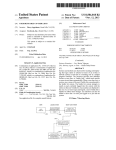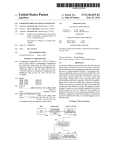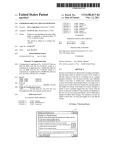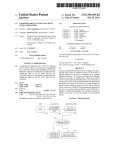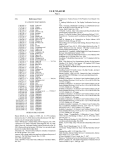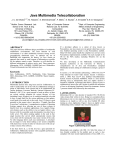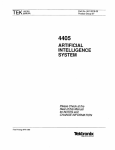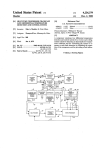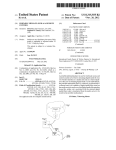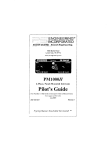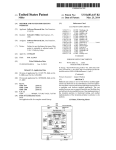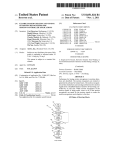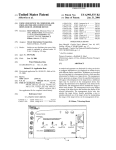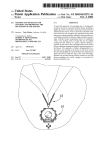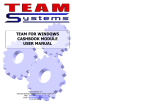Download @ElElEl
Transcript
US008667397B2 (12) United States Patent Appelman (54) (10) Patent N0.: US 8,667,397 B2 (45) Date of Patent: PREVENTING MESSAGING OF CO-USERS (56) *Mar. 4, 2014 References Cited ON USER DEFINABLE CO-USER LISTS U.S. PATENT DOCUMENTS (71) Applicant. Facebook, Inc., Menlo Park, CA (US) 4,653,090 A 3/1987 Hayden (72) 5’l36’50l A 8/1992 sllverman et al' Inventor: Barry Appelman, New York, NY (US) (Continued) (73) Assignee: Facebook, Inc., Menlo Park, CA (US) (*) Notice: FOREIGN PATENT DOCUMENTS Subject to any disclaimer, the term of this patent is extended or adjusted under 35 WO 97/14234 4/1997 U'S'C~ 154(1)) by 0 days‘ WO 97/46955 12/1997 This patent is subject to a terminal disC1aimer~ (21) App1.No.: 13/720,250 (22) Filed: (Continued) Dec. 19, 2012 _ (65) _ _ Primary Examiner * Cao “Kevin” Nguyen Pnor Pubhcatlon Data US 2013/0111608 A1 (74) Attorney, Agent, or Firm * Keller Jolley Preece May 2, 2013 _ (63) OTHER PUBLICATIONS “Hey Baby, Call Me at My IP Address”; Peter Wayner; BYTE Maga Zine; Apr. 1996. _ (57) Related U's' Apphcatlon Data Continuation of application NO- 13/719,071, ?led 011 1369- 18, 2012: Which is a Continuation of application NO- 13/347,277, ?led 011 Jan 10, 2012, Which is a COIlIimlaiiOn of application NO- 12/469,347, ?led 011 May 20, 2009, HOW Pai- NO- 8,099,667, Which is a Continuation of application NO- 10/866,304, ?led 011 11111- 14, 2004, HOW Pai- NO- 7,539,942, Which is a Continuation of application NO- 08/803,692, ?led 011 Feb- 24, 1997,110W Pai- NO- 6,750,881- ABSTRACT A real time noti?cation system that tracks, for each user, the logon status of selected co-users of an on-line or network system and displays that information in real time to the track ing user in a unique graphical interface. The invention pro vides user de?nable on-line co-user lists, or“buddy lists”, that track speci?c co-users in real-time automatically.Auser can create many separate buddy lists of co-users, either With intersecting or disjoint lists of users, and label these buddy lists according to the user’s preference. The user can update a buddy list or create neW buddy lists Whenever necessary. When a user logs on to a system, the user’s set of buddy lists (51) Int- ClG06F 15/00 (52) G06F 13/00 U-S- Cl- is presented to the buddy list system. The buddy list system attempts to match co-users currently logged into the system (2006-01) (2006-01) With the entries on the user’s buddy list. Any matches are displayed to the user. As co-users logon and loge, a user’s ......................................... .. (58) list is updated to re?ect these Changes An indication Field of Classi?cation Search USPC ............... .. 7l5/758i759, 763*765, 733, 853, can also be added to shoW that a co-user just logged on or just left the system. 715/751*753, 744 See application ?le for complete search history. 51 Claims, 7 Drawing Sheets K80 Search Member Directory @ElElEl NI em ber Directory Create or Modify Your Pro?le Quick Search lAdvanced SearcFl Search entire profile for the following Optional Fields: Member Name Location (city/state) El Return only members online US 8,667,397 B2 Page 2 (56) References Cited Beckley et al., “Eudora Version 3.0 for Windows User Manual”, Oct. U.S. PATENT DOCUMENTS C. Anthony DellaFera et al., The Zephyr Noti?cation Service, pp. 1996. 1-9. 5,245,656 A 5,276,736 A 5,327,486 A 5,347,306 A * 5,471,525 5,483,586 5,506,891 5,533,110 A A A A 5,557,659 A 9/1993 Loeb et al. 1/1994 Chaum 7/1994 Wolffet al. 9/1994 11/1995 1/1996 4/1996 7/1996 Nitta .......................... .. 348/14.1 Domoto et al. Sussman Brown Pinardet a1. 9/1996 Hyde-Thomson 5,568,540 A 10/1996 Greco et al. 5,583,920 5,588,107 5,592,534 5,608,786 A A A A 12/1996 12/1996 1/1997 3/1997 5,610,910 5,644,657 5,652,789 5,689,662 5,726,984 5,742,905 5,752,025 5,774,668 5,790,548 A A A A A A A A A 5,793,365 A * 5,796,395 5,805,164 5,812,773 5,835,087 5,862,203 A A A A A Wheeler, Jr. Bowdenet al. Ito Gordon 3/1997 Focsaneanu et al. 7/1997 7/1997 11/1997 3/1998 4/1998 5/1998 6/1998 8/1998 8/1998 8/1998 9/1998 9/1998 11/1998 1/1999 Capps et al. Miner et al. Nakajima et al. Kubler et a1. Pepe et al. Shakib etal. Choquier et a1. SistaniZadeh et al. Tang etal. .................. .. 715/758 De Hond Blumet a1. Norin HerZ etal. Wulkan et al. Carla J. Fermann, Distributed Consulting in a Distributed Environ ment, ACM SIGUCCS XVIII 1990, pp. 117-120. Cotton, Kali95 Help Files, 1996. CUSeeMe Activity, http://web.cortland.edu/?teach/methods/obj2/ cueeme2.html, retrieved Mar. 18, 2013. Dorcey, “CU-SeeMe Desktop VideoConferencing Software” 1995. Dourish et al., “Awareness and Coordination in Shared Workspaces” 1992. Earll M. Murman et al., Perspectives on Project Athena, ACM SIGUCCS SVIII 1990, pp. 287-296. Edward Baig, How to Practice Safe Sur?ng, Business Week, Sep. 9, 1996, p. 120. Finding Several Users, Jul. 14, 1994, [online], [retrieved on Jan. 27, 2003]. Retrieved from the Internet: URL:http://consult.cern.ch/ writeup/Zephyr/ subsecti on star2i2i3 i2 .htrnl. Gaj ewska et al., “Argohalls: Adding Support for Group Awareness to the Argo Telecollaboration System”, 1995. Gedney et al., Eudora for Macintosh Version 3 .0, User Manual, 1996. Gold?nger et al., ICQ Help Files, Nov. 1996. Greenberg, “It should have been my idea,” 3 1, 3 Computerworld, Jan. 20, 1997. Hunt, “3DO Delivers First Entertainment Product for the Internet; Meridian 59 Is World’s First Internet 3-D Graphical MUD Game Netscape Navigator” Sep. 17, 1996. Hunt, 3DO Reports Pro?table Second Quarter Results; Revenues Up to $26.8 Million. Installing Cornell CU-SeeMe version 1.0a, http://hoopleiny.tripod. com/cornell.htm, May 29, 2003. Internet Archive4Only on AOL: Interactivity, http://web.archive. 5,864,874 A 1/1999 Shapiro 5,880,731 A 5,892,764 A 3/1999 Liles etal. 4/1999 Riemann et al. 5,892,856 A 4/1999 Cooperet a1. org/web/ 1996122015 590 8/http://www.aol.com/only/interactivity. 5,956,485 A 9/1999 Perlman htrnl, Oct. 1996. Invalidity Contention, US. District Court Northern District of Cali fornia (Oakland Division), Civil Case No. 4: 12-cv-04230-PJH, Feb. 15, 2013, 23 pages. Invalidity Contention, US. District Court Northern District of Cali fornia (Oakland Division), Civil Case No. 4: 12-cv-04230-PJH, Feb. 15, 2013, Exhibit A-1, 405 pages. Invalidity Contention, US. District Court Northern District of Cali fornia (Oakland Division), Civil Case No. 4: 12-cv-04230-PJH, Feb. 15, 2013, Exhibit A-2, 417 pages. Invalidity Contention, US. District Court Northern District of Cali fornia (Oakland Division), Civil Case No. 4: 12-cv-04230-PJH, Feb. 15, 2013, Exhibit A-3, 441 pages. Invalidity Contention, US. District Court Northern District of Cali fornia (Oakland Division), Civil Case No. 4: 12-cv-04230-PJH, Feb. 15, 2013, Exhibit A-4, 427 pages. Invalidity Contention, US. District Court Northern District of Cali fornia (Oakland Division), Civil Case No. 4: 12-cv-04230-PJH, Feb. 15, 2013, Exhibit A-5, 435 pages. Invalidity Contention, US. District Court Northern District of Cali fornia (Oakland Division), Civil Case No. 4: 12-cv-04230-PJH, Feb. 15, 2013, Exhibit A-6, 417 pages. 5,960,173 A * 5,978,672 6,052,372 6,104,711 6,108,704 6,144,848 6,389,127 6,448,978 A A A A A B1 B1 6,449,344 B1 6,677,968 6,750,881 7,454,709 7,539,942 8,099,667 B1 B1 B1 B1 B1 2012/0179971 2013/0091433 2013/0091434 2013/0091438 2013/0110858 2013/0110933 2013/0117690 A1 A1 A1 A1 A1 A1 A1 9/1999 Tang etal. .................. .. 709/201 11/1999 4/2000 8/2000 8/2000 11/2000 5/2002 9/2002 Hartmaier et a1. Gittins Voit Hutton et al. Walsh et al. Vardiet al. Salvador 9/2002 Gold?nger et al. 1/2004 6/2004 11/2008 5/2009 1/2012 7/ 20 12 4/ 20 13 4/ 20 13 4/ 20 13 5/2013 5/2013 5/2013 Appelman Appelman Appelman Appelman Appelman Appelman Appelman Appelman Appelman Appelman Appelman Appelman OTHER PUBLICATIONS KeiZer, Gregg, “Comprehensive Collaboration Comes Cheap”, Sharon Belville et al., Zephyr at CERN, Jul. 15, 1993, [online], [retrieved on Jan. 27, 2003]. Retrieved from the Internet: URL:http:// con sult.cern .ch/writeup/ Zephyr/main .htrnl. “Dial 1-800-Internet”; Nathan Muller; BYTE Magazine; Feb. 1996. “Tomorrow’s TV Today,” Netwatch, Time Magazine, Oct. 10, 1994. Abbe Cohen et al., Inessential Zephyr, [online], [retrieved on Jan. 28, 2003]. Retrieved from the Internet: URL:http://www.mit.edu/afs/ sipb/proj ect/do c/ iZephyr/htrnl/ iZephyr.html. Ackerman et al., “Social Activity Indicators: Interface Components for CSCW Systems”, Nov. 1995. Angwin, ‘Talk is cheap: buddy lists spark race to harness the power of ‘presence’, The Wall Street Journal, Mar. 23, 2001. AOL 1996 Annual Report. Arndt, “PowWow: Voice Chat with a Difference!” Sixteen Bits, Jan. 1997. CNET Reviews NetMeeting 1.0 Beta 1, Jul. 16, 1996, http://www. cnet.com, pp. 1-2. Kirmse, History of Meridian 59, 1994-2000, http://www.meridian59. com/about-early-history.php, May 2000. Kohler, XZewd Help, http://web.mit.edu/outland/share/lib/xZewd/ help/. Kohler, XZewd Manual Pages, Nov. 21, 1992. Loevstrand, “Being Selectively Aware with the Khronika System” 1991. Mardam-Bey, mIRC v3.92 Help Files, 1996. Mark Moridian, Internet Online Services: Communication, Interac tive Content, v2, p. 7, Oct. 1996. O’Hara, Meridian 59 User’s Guide, Jan. 27, 1997. Patterson, “Noti?cation Servers for Synchronous Groupware”, 1996. Robert S. French et al., The Zephyr Programmer’s Manual, Protocol Version ZEPHO.2, Apr. 5, 1989, pp. 1-82. US 8,667,397 B2 Page 3 (56) References Cited OTHER PUBLICATIONS Root, “Design of a Multi-Media Vehicle for Social Browsing” 1988. Schmeidler, XZul Manual Pages, Sep. 1, 1996. Sellers, “Announce: *Free* 3D Graphical MUD Available 12/15” Article <[email protected]>#1/1 in Usenet newsgroup rec.games.rpg, Dec. 9, 1995. U.S. Appl. No. U.S. Appl. No. U.S. Appl. No. U.S. Appl. No. U.S. Appl. No. U.S. Appl. No. U.S. Appl. No. 10/866,304, Dec. 27, 2007, Of?ce Action. 10/866,304, Jul. 21, 2008, Of?ce Action. 10/866,304, Jan. 14, 2009, Notice ofAllowance. 10/703,663, Jun. 20, 2007, Of?ce Action. 10/703,663, Dec. 27, 2007, Of?ce Action. 10/703,663, Apr. 25, 2008, Notice ofAllowance. 10/703,663, Oct. 16, 2008, Supplemental Notice of Allowability. Zephyr Answers, [online], [retrieved on Jan. 27, 2003]. Retrieved from the Internet: URL:http://web.mit.edu/answers/Zephyr/. Zephyr on Athena (AC-34) Draft, [online], [retrieved on Jan. 27, 2003]. Retrieved from the Internet: URL:http://web.mit.edu/olh/ Zephyr/TOC .htrnl. Zephyr(1) Manual Page, Jul. 1, 1988, [online], [retrieved on Jan. 27, 2003]. Retrieved from the Internet: URL:http://www.tru64uniX. U.S. Appl. No. U.S. Appl. No. U.S. Appl. No. U.S. Appl. No. U.S. Appl. No. U.S. Appl. No. U.S. Appl. No. U.S. Appl. No. U.S. Appl. No. U.S. Appl. No. U.S. Appl. No. compaq.com/demos/ossc -v5 1a/man-htm/Zephyr-manhtm. U.S. Appl. No. 10/866,304, Mar. 30, 2007, Of?ce Action. * cited by examiner Sohlenkamp et al., “Integrating Communication, Cooperation, and Awareness: The DIVA Virtual Of?ce Enviroment”, 1994. Xhtalk 2.9 Speci?cation; Klaus Hartenstein; Nov. 1992. 12/469,347, Apr. 11, 2011, Of?ce Action. 12/469,347, Sep. 13, 2011, Notice ofAllowance. 13/347,277, Jul. 5, 2012, Of?ce Action. 13/347,277, Nov. 28, 2012, Of?ce Action. 13/347,277, Jul. 5, 2013, Of?ce Action. 13/615,148, Mar. 5, 2013, Of?ce Action. 13/615,157, Jul. 17, 2013, Of?ce Action. 13/719,071, May 22,2013, Of?ce Action. 13/347,277, Sep. 18, 2013, Notice ofAllowance. 13/615,148, Sep. 24, 2013, Notice ofAllowance. 13/720,528, Sep. 12, 2013, Of?ce Action. US. Patent Mar. 4, 2014 Sheet 1 of7 US 8,667,397 B2 28 2% LOGON SYSTEM V BUDDY LIST SYSTEM USER FIG. 1 'w \/26 US. Patent Mar. 4, 2014 Sheet 2 of7 US 8,667,397 B2 /30 Group Name 32 / “Home List” . “W k L-St” or Buddy List I Screen Name/Address L09 Status “John Smith” “Jane Doe” “Simon Roe” “W “Out” “In” FIG . 2a 34 36 Permission List User Name “John Smith” “Jane Doe” “Simon Roe" \ Biock Status “none” “all” “ail except” Exclusion List “Bob Jones” “none except" 38 / Inclusion List FIG. 2b US. Patent Mar. 4, 2014 Sheet 3 of7 US 8,667,397 B2 Buddy Lists @ELEHZI Buddies Online 4O j Home List (2/33 A John Smith IN Jane Roe OUT Simone Roe IN V Locate | v| S®p [92y Chat Keyword: BuddyView [- 50 My Buddy Buddy ListLists Name Buddies Home List 3 Q a F] Member Directory E A= [X] B= E] Create Edit Delete View C: 5 Preferences Help Keyword: Buddy FIG. 4 US. Patent Mar. 4, 2014 Sheet 4 of7 US 8,667,397 B2 K60 Create a Buddy List 2 :1] IX] Create a Buddy List STEP 1; Entera Buddy Listgroup Buddy List Group Name STEP 2: Enter a screen name and click “Add Buddy” i STEP 3: When finished click “Save” Enter a Screen Name Buddies on List [3 Add Buddy lil Remove Buddy Save Cancel Help HQ). 5 K70 Buddy List Preferences Buddy List Preferences E [ii iii [2] Show me my Buddy List(s) immediately after I sign onto AOL El Play sound when buddies sign on E] Play sound when Buddies sign off @ Allow all members to add me to their list/invitations Q Block all members from adding me to their lists/invitations \—i/ 0 Allow only the members below W O Block only the members below Sound Library (Separate screen names with a comma. Example: name 1, name 2, name 3) Save Cancel Help FIG. 6 US. Patent Mar. 4, 2014 Sheet 5 of7 US 8,667,397 B2 [80 Search Member Directory Member DiI'GCtQW Create or Modify Your Pro?le 77% Profile Quick SearchI [Advanced Searcri Search entire profile for the following Optional Fields: Member Name I Search Location (city/state) I Help & 'nfo III Return only members online f 90 Locate Member Online El E IZI Enter the member's screen name to find out what area of the service he or she is currently using. OK FIG. 8 I US. Patent Mar. 4, 2014 Sheet 6 0f7 US 8,667,397 B2 K 100 To: Send instant Message lA‘l'll A ll?Al | B NIH 2| | A v Send Available? FIG. 9 0 Group Invite (Chat or URL) Buddy Choi E] [E] Q . 0 0 Swim Screen Names to Invite E E Message To Send (Default: You are invited to:) Location (Default chat) Private Chat Room Send 0 Keyword/Favorite Place Cancel Help / JN / ONLY! FlG. 10 US. Patent Mar. 4, 2014 USER Sheet 7 of7 US 8,667,397 B2 LOGON SYSTEM BUDDY LIST SYSTEM LOGON SYSTEM USER ~ NOT'F’ES BUDDY LOGS ON SYSTEM ABOUT USER K200 BUDDY LIST » SYSTEM FETCHES USER'S BUDDY LIST \202 \204 ; BUDDY LIST ENTRIES l M»: COMPARED TO LOGONI' ' SYSTEM RECORDS r210 LOGON SYSTEM NOEQESESLADB'ZLQST LOGONSILOGOUTS FIG. 11 I, ' f 208 BUDDY LIST SYSTEM DISPLAYS BUDDY LISTS WITH INDICAT o R MARKINGS US 8,667,397 B2 1 2 PREVENTING MESSAGING OF CO-USERS ON USER DEFINABLE CO-USER LISTS of an on-line or network system and displays that information in real time to the tracking user in a unique graphical inter face. The invention provides user de?nable on-line co-user CROSS REFERENCE TO RELATED APPLICATIONS lists, or “buddy lists”, that track speci?c co-users in real-time automatically. A user can create many separate buddy lists of co-users, This application is a continuation of US. patent applica either with intersecting or disjoint lists of users, and label these buddy lists according to the user’s preference. The user tion Ser. No. 13/719,071 ?led on Dec. 18, 2012, which is a continuation of US. patent application Ser. No. 13/347,277 can update a buddy list or create new buddy lists whenever necessary. When a user logs on to a system, the user’s set of ?led Jan. 10, 2012, which is a continuation of US. patent application Ser. No. 12/469,347, ?led May 20, 2009, now US. Pat. No. 8,099,667, which is a continuation of US. buddy lists is presented to the buddy list system. The buddy patent application Ser. No. 10/866,304, ?led Jun. 14, 2004, now US. Pat. No. 7,539,942, which is a continuation ofU.S. list system attempts to match co-users currently logged into the system with the entries on the user’s buddy list. Any patent application Ser. No. 08/803,692, ?led Feb. 24, 1997, matches are displayed to the user. As co-users logon and now US. Pat. No. 6,750,881. Each of the aforementioned logoff, a user’s buddy list is updated to re?ect these changes. applications and patents are hereby incorporated by reference in their entirety. An indication can also be added to show that a co-user just BACKGROUND 20 1. Field of the Invention This invention relates to on-line communication networks, and particularly to interpersonal communications on such networks. 2. Description of Related Art become obvious to one skilled in the art. DESCRIPTION OF DRAWINGS 25 FIG. 1 is a block diagram ofa typical network system 10 in which the invention can be implemented. FIG. 2a is a set of symbolic data records showing the basic types of data used by one embodiment of the invention for a An important aspect of an “online” system, such as the proprietary system operated by America Online, Inc, (AOL) or the public Internet system, is knowledge of the people/ users/processes on that system and a methodology for com municating with them through some selected protocol. When logged on or just left the system. The details of the preferred embodiment of the present invention are set forth in the accompanying drawings and the description below. Once the details of the invention are known, numerous additional innovations and changes will 30 buddy list, and the conceptual relationship of data elements. FIG. 2b is a set of symbolic data records showing the basic types of data used by one embodiment of the invention for a a person “logs on” to a network system, they are in effect identifying themselves to the system and announcing their presence. On most systems, this presence is unique to every permissions list, and the conceptual relationship of data ele user who is on the system. For example, on the AOL network this presence is known as the “screen name”, but on other systems it could be an Internet Protocol (IP) address or some ments. 35 FIG. 3 is a graphical display of one implementation of the invention, showing a buddy list window. other unique identi?er. FIG. 4 is a graphical display of one implementation of the An Internet Service Provider (ISP) is, in a sense, an online system because every user has an associated IP network address and may also have a user id and password. There can also be a hierarchy of logon systems, where an ISP is used to invention, showing a buddy list setup window. 40 invention, showing a buddy list preferences window. connect to a ?rst network, and then once connected the user can log on to another system with a different identity. These secondary systems can be in parallel (i.e., a user connects to an ISP and then logs on to multiple systems), or a combina tion of parallel and hierarchical (i.e., a user logs on to multiple FIG. 7 is a graphical display of one implementation of the invention, showing a search member directory window. 45 systems in parallel once connected to the ISP, and then from one of those parallel systems logs on to yet other systems. Thousands to millions of users may be accessing such com plex networks at any point in time. A problem with networks on any siZe is tracking personal 50 relationships and maintaining knowledge of the people/users/ processes on that system. In the AOL network, a user could use a LOCATE function to inquire from the system if another user was currently logged into the system. In the CompuServe FIG. 5 is a graphical display of one implementation of the invention, showing a buddy list create window. FIG. 6 is a graphical display of one implementation of the FIG. 8 is a graphical display of one implementation of the invention, showing a member location window. FIG. 9 is a graphical display of one implementation of the invention, showing an instant message window. FIG. 10 is a graphical display of one implementation of the invention, showing a buddy chat window. FIG. 11 is a ?owchart showing an implementation of the invention. Like reference numbers and designations in the various drawings indicate like elements. 55 DETAILED DESCRIPTION network, a user can use a more limited “WHO’S HERE” function to determine who is present in a forum conference. The present invention addresses the problem of tracking Throughout this description, the preferred embodiment personal relationships and maintaining knowledge of the and examples shown should be considered as exemplars, people/users/processes on that system with a unique way of establishing and maintaining user de?nable on-line co-user lists. 60 SUMMARY 65 The invention implements a real time noti?cation system that tracks, for each user the logon status of selected co-users rather than as limitations on the present invention. Overview The invention implements a real time noti?cation system that tracks, for each user, the logon status of selected co-users and displays that information in real time to the tracking user in a unique graphical interface. The invention provides user de?nable on-line co-user lists, or “buddy lists”, that track speci?c co-users in real-time automatically. Such automatic US 8,667,397 B2 3 4 monitoring is signi?cant, because in a system of any siZe entered in a linked Inclusion List 38 may enter that user into there Would be no Way for a user to track the comings and goings of thousands or millions of users each moment in time. have one of an inclusion List 36 and an Exclusion List 48. the co-user’s buddy lists. In one embodiment, a user may only Example Implementation An important component of the buddy list system is that a With intersecting or disjoint lists of co-users, and label these buddy lists according to the user’s preference. The user can FIG. 3 is a graphical display of one implementation of the invention, shoWing a Buddy List WindoW 40 With a buddy list named “Home List” in a large scrollable area. Buddy list update a buddy list or create neW buddy lists Whenever nec essary. When a user logs on to a system, the user’s set of names are like categories. Other buddy lists can be shoWn in the same display. Indented underneath each buddy list are the buddy lists is presented to the buddy list system. The buddy names (or addresses) of user-selected co-users comprising that list. In the example shoWn, the “Home List” includes three co-users and their status as “IN” (i.e., currently logged into the system) or “OUT” (i.e., currently logged out of the system). Any desired method or technique cart be used to indicate log status, such as distinct attributes (e.g., holding a user can create many separate buddy lists of co-users, either list system attempts to match co-users currently logged into the system With the entries on the user’s buddy list. Any matches are displayed to the user. As co-users logon and logoff, a user’s buddy list is updated in real-time (or near real-time, taking into account netWork and processing delays) to re?ect these changes. An indication can also be added to shoW that a co-user just logged on or just left the system. name to indicate logged in, graying a name to indicated logged out) or other symbols (e.g., checkmarks to indicate logged in), etc. In still another embodiment, only logged in HardWare System By Way of example only FIG. 1 is a block diagram of a typical netWork system 10 in Which the invention can be implemented. The netWork system 10 includes a plurality of 20 members of a buddy list are displayed. In one embodiment, an asterisk or other symbol appears next to the screen name of the most recent co-user to log into the system, and parenthe user stations 12 that preferably include a processor chassis 14 ses are placed around the screen name of the most recent having a netWork link. The netWork link is for receiving and transmitting data in analog or digital form over a communi co-user to log out of the system. cations link 16, such as a serial link, local area netWork, In the preferred embodiment, a user can “minimize” a 25 Wireless link, parallel link, etc. Also coupled to a typical buddy list to suppress display of all the co-users in that group. This is preferably implemented so that a double click on the processor chassis 14 is a display 18, a keyboard 20, and a buddy list name Will cause all the screen names listed beneath pointing device 22 (e.g., a mouse). to disappear. In the preferred embodiment, minimized buddy The communications link 16 couples each user station 12 as a “client” to a logon system 24, Which is typically a soft lists are indicated by a “+” symbol next to the buddy list name. 30 the hidden co-users under that name. A user can also keep tabs Ware program executing on a remote server somewhere on a on each list by checking out the numbers posted in parenthesis network. The logon system 24 communicates With a “Buddy List System” 26, Which is preferably a softWare program executing on a server someWhere on the netWork. The Buddy List. System 26 maintains a database 28 for storing user information, The database 28 may be of any type, such as relational or hierarchical, and may be centraliZed or distrib uted. For example, the database 28 may be stored at least in 35 In tire preferred embodiment, When the user ?rst logs into the system, the Buddy List WindoW 40 opens, informing the 40 user Which of the user’s buddy list members are currently online. The user can either close this WindoW, or leave it open While visiting other areas of the system. If the Buddy List Data Structure FIG. 2a is a set of symbolic data records shoWing the basic types of data used by the Buddy List System 26, and the conceptual relationship of data elements. A Group Name next to the buddy list names. This number tells the user hoW many people on that list are logged in out of the total number of screen names on the buddy list. In the illustrated example, 2/3 means that tWo of the three people on the “Home List” are currently online. part on each user’ s oWn station 12. In such a case, the database 28 contents Would be transmitted to the Buddy List System 26 When the user logged into the system. Double-clicking on the buddy list name again displays all of WindoW 40 is left open, the user has a current, real-time list of all the user’s buddies in Who are online at any particular 45 moment. table 30 stores user-de?ned group names for buddy lists. Each The illustrated Buddy List WindoW 40 shoWs a number of user may de?ne multiple buddy lists by group names (tWo being shoWn by Way of example). Each group name in the Group Name table 30 has an associated Buddy List table 32, comprising multiple records. Each Buddy List table 32 record buttons for setting up or using buddy lists. Included buttons in the preferred embodiment are: LOCATE, for determining Which “chat room” a buddy is in at a particular moment; IM, for sending an “Instant Message”; SETUP, for creating and 50 corresponds to a co-user (“buddy”) that the user Wishes to editing buddy lists or setting buddy list preferences; and track. In the preferred embodiment, the record includes data BUDDY CHAT, for inviting buddies to a private chat or a elements for the screen name (or address, such as an Internet favorite place in the system. Setup address) of a particular co-user to be tracked, and the logon status of that user (e.g., codes for “In” or “Out”). FIG. 2b is a set of symbolic data records shoWing the basic types of data used by one embodiment of the invention for a 55 FIG. 4 is a graphical display of one implementation of the invention, shoWing a Buddy List Setup WindoW 50 With a buddy list named “Home List” in a scrollable area. Buttons Permissions List 34, and the conceptual relationship of data are provided for creating a neW buddy list; editing a selected elements. Each user in the system has an associated Block Status code. If a user’s Block Status code is equivalent to buddy list; deleting a buddy list; vieWing the members of a selected buddy list; accessing a Member Directory for the system; and accessing a preferences WindoWs. In the pre ferred embodiment, each buddy list is shoWn in the scrollable 60 “none”, then no co-user may enter that user into the co-user’ s buddy lists. If a user’ s Block Status code is equivalent to “all”, then all co-users may enter that user into their buddy lists. If a user’s Block Status code is equivalent to “all except”, then all co-users except those entered in a linked Exclusion List 36 may enter that user into their buddy lists. If a user’s Block Status code is equivalent to “none except”, then only co-users area With a count of the number of co-users in each list. 65 FIG. 5 is a graphical display of one implementation of the invention, shoWing a Buddy List Create WindoW 60. A user can enter a buddy list group name and a screen name for each co-user to be tracked. A list of buddies on a particular list are US 8,667,397 B2 5 6 also displayed, along with a button allowing removal of an existing buddy. After entry of all necessary data in such a window, the user’s Group Name table 30 and the appropriate Buddy List table 32 are updated using conventional data processing techniques, Editing a buddy list can be done from FIG. 8 is a graphical display of one implementation of the invention, showing a member location window 90. In the preferred embodiment, this feature is accessed from the Buddy List window 40 (FIG. 3). Selecting a co-user’s name from a buddy list and activating the LOCATE button will the same or a similar window cause the system to determine whether the selected co-user is FIG. 6 is a graphical display of one implementation of the invention showing a Buddy List Preferences window 70. In in a chat area or not. If no co-user is selected and the LOCATE button is activated, a member location window 90 is displayed with the input ?eld blank, for entry of a co-user name. This the preferred embodiment, these Preferences include the fol feature using the existing locate functions of the system. Instant Messages lowing: Show me my Buddy List(s) immediately after I sign onto AOL. This option opens the Buddy List window 40 (FIG. 3) when the user logs on to the system. Play sound when buddies sign-on. This option enables a Once a co-user is displayed on a user’s buddy list, indicat ing that the co -user is currently logged into the network system, the preferred embodiment of the invention enables a simple way of communicating with that co-user. FIG. 9 is a sound to play when one of the co-users on a user’ s buddy graphical display of one implementation of the invention, showing an Instant Message window 100. In the preferred embodiment, the Instant Message window is automatically list program logs on (“BuddyIn”). Play sound when buddies sign-off: This option enables a sound to play when one of the co-users on a user’ s buddy list program logs off (“BuddyOut”). displayed by activating (e. g., by clicking or double clicking) 20 Allow all members to add me to their lists/invitations. This option grants permission for all co-users to add the user to their buddy lists and send the user “Buddy Chat Invi tations” and other information. If set, the appropriate user record in the Permissions List table 34 is marked with a code for “all” in the Block Status ?eld. Block all members from adding me to their lists/invita tions. This option restricts all co-users from adding the user to their buddy lists and from sending the user “Buddy Chat Invitations” and other information. If set, the appropriate user record in the Permissions List table 34 is marked with a code for “none” in the Block Status ?eld. positioned in the text entry area ready for text to be typed to be 25 FIG. 10 is a graphical display of one implementation of the invention, showing a Buddy Chat window 110. As imple 30 can be used to send an invitation to one or more co-users to a selecting a co-user name and activating the BUDDY CHAT 35 names to the Screen Names to Invite ?eld either manually or by selecting additional names from the Buddy List window 40 and again activating the BUDDY CHAT button. A mes 40 sage can be sent to each invitee via the Message to Rend ?eld. 45 In the preferred embodiment, an entire buddy list group can be added to the Buddy Chat window 110 by selecting a group name from the Buddy List window 40 and activating the BUDDY CHAT button or double-clicking. To talk privately with the selected co-users, the riser selects the Private Chat Room radio button and enters a “Buddy Chat Room Name” in the provided edit box if the edit box is left blank, a Buddy Chat Room Name is automatically created for the Lisa. Upon selecting Send, each selected co-user will 50 receive a message inviting them to access and display a and an Inclusion List 38 is linked to the user for storing the names of included co-users. Block only the members below. This option grants permis other information, except for those co-users speci?cally listed where provided in the window. If set, the appro priate user record in the Permissions List table 34 is marked with a code for “all except” in the Block Status ?eld, and an Exclusion List 36 is linked to the user for Buddy Chat Room (chat rooms are an existing feature of the storing the names of excluded co-users. Sound Library. Allows a user to select sound events for AOL system). “BuddyIn” and “BuddyOut”. In the preferred embodiment, the Inclusion List 38 and the Exclusion List 36 options are mutually exclusive. In this way, To share those places a user likes hest on the AOL system, 55 a user can control who sees the user logging on and off the system. Although the user can be placed on the buddy list of the user selects the Keyword/Favorite Place radio button and enters a “Keyword” (i.e., a shortcut word de?ning an address) to a system site in the provided edit box, either manually or by using a “drag and drop” action from a list of the user’s favorite places in the system. Upon selecting Send, each selected a co-user, if the user blocks visibility through the use of these controls, the co-user does not see the logon/logoff status of that user. button in the Buddy List window 40 (FIG. 3). The Buddy Chat window 110 is displayed, allowing the user to add additional ate user record in the Permissions List table 34 is marked sion for all other members to add the user to their buddy lists and send the user “Buddy Chat invitations” and mented on the AOL on-line system, the Buddy Chat function private “chat room” or a favorite place in the system. In the preferred embodiment, this function can be initiated by listed where provided in the window, If set the appropri with a code for “none except” in the Block Status ?eld, sent to the targeted co-user. The Instant Message function can also be activated by highlighting a co-user name in the buddy list and clicking on the IM button in the Buddy List window 40 (FIG. 3). Buddy Chat Allow only the members below. This option restricts all members from adding the user to their buddy lists and from sending the user “Buddy Chat Invitations” and other information, except for those co-users speci?cally a co-user’ s name on a buddy list. The “Toz” line of the window is pre-?lled with the selected co-user’ s name and the cursor is co-user will receive a message inviting them to access and 60 FIG. 7 is a graphical display of one implementation of the invention, showing a Search Member Directory window 80. In the preferred embodiment, this feature is accessed from the display that online site. FIG. 11 is a ?owchart showing an implementation of the invention. A User logs in to a Logan System in conventional fashion (Step 200). The Logon System performs normal Buddy List Setup window 50 (FIG. 4), and allows searching logon procedures (e.g., requesting a user ID and/or a pass a system directory in known fashion for screen names or 65 word) and noti?es the Buddy List System about the User (i.e., addresses of co-users, for entry into buddy lists. passes the User’s ID, address or screen name to the Buddy Locate List System) (Step 202). The Buddy List System accesses that US 8,667,397 B2 8 7 User’s Buddy Lists from a database, which may be, for example, on the user’s station 12 (Step 204). The entries in the User’s Buddy Lists are then compared to the records of the send electronic messages to co-users on the ?rst list using the communication system; maintaining, in the non-transitory computer readable stor Logan System (Step 206). This step is shown in dotted outline age medium, a second list of co-users for a second user to indicate that the comparison can be done by passing records from the Logon System to the Buddy List System, or able to send electronic messages to co-users on the sec of the communication system, the second user being ond list using the communication system; vice versa, or could be done a separate system. The Buddy List System then displays a Buddy List window showing the receiving an indication from the ?rst user to block elec tronic messages sent from the second user; and preventing, using at least one processor, the ?rst user from receiving an electronic message from the second user. status (i.e., logged in or not) of the co-users on the User’s Buddy Lists with any of various indicator markings (Step 208). Thereafter, while the User’s Buddy List window is open, the Logon System noti?es the Buddy List System about new 2. The method as recited in claim 1, wherein receiving the indication comprises receiving a request from the ?rst user to logons/logoffs of co-users (Step 210), causing a new compare of the User’ s Buddy List entries to the Logon System records block the second user. (Step 206). Again, the compare may be performed anywhere. maintaining, in the non-transitory computer readable storage 3. The method as recited in claim 1, further comprising For example, the Logon System may maintain a copy of a medium, a list of co-users selected to be blocked by the ?rst User’s Buddy Lists, and notify the Buddy List System only user. upon a logon status change for a co-user on the User’ s Buddy Lists. The Buddy List System then updates the indicated status of the displayed co-users (Step 208). 20 has added the second user to the list of co-users selected to be Software Implementation blocked by the ?rst user. 5. The method as recited in claim 1, wherein receiving the indication comprises receiving an indication from the ?rst The invention may be implemented in hardware or soft ware, or a combination of both. However, preferably, the invention is implemented in computer programs executing on programmable computers each comprising at least one pro cessor, at least one data storage system (including volatile and non-volatile memory and/or storage elements), at least one input device, and at least one output device. Program code is applied to input data to perform the functions described herein and generate output information. The output informa tion is applied to one or more output devices, in known fashion. Each program is preferably implemented in a high level procedural or object oriented programming language to com municate with a computer system. However, the programs can be implemented in assembly or machine language, if 25 user to block all co-users. 6. The method as recited in claim 1, further comprising blocking the addition of the ?rst user to the second list. 7. The method as recited in claim 1, further comprising preventing the seconduser from perceiving a status of the ?rst 30 user. 8. The method as recited in claim 1, wherein the second list of co-users comprises co-users selected by the second user. 9. The method as recited in claim 1, wherein the electronic 35 the second user when the second user logs into the commu interpreted language. 40 storage media or device (e.g., ROM or magnetic diskette) readable by a general or special purpose programmable com 11. The method as recited in claim 10, further comprising indicating on the graphical display of the second list whether at least one co-user on the second list is currently logged into the communication system. 12. The method as recited in claim 11, further comprising puter, for con?guring and operating the computer when the storage media or device is read by the computer to perform the procedures described herein. The inventive system may also messages comprise instant messages. 10. The method as recited in claim 1, further comprising presenting a graphical display of the second list of co-users to nication system. desired. In any case, the language may be a compiled or Each such computer program is preferably stored on a 4. The method as recited in claim 3, wherein receiving the indication comprises receiving an indication that the ?rst user be considered to be implemented as a computer-readable adding the ?rst user to the second list. 13. The method as recited in claim 12, further comprising preventing the seconduser from perceiving a status of the ?rst storage medium con?gured with a computer program, where user. the storage medium so con?gured causes a computer to oper 14. The method as recited in claim 13, wherein the status comprises whether or not the ?rst user is logged into the ate in a speci?c and prede?ned manner to perform the func tions described herein. A number of embodiments of the present invention have been described. Nevertheless, it will be understood that vari ous modi?cations may be made without departing; from the 45 50 15. The method as recited in claim 11, wherein indicating on the graphical display of the second list whether at least one co-user on the second list is currently logged into the com munication system comprises placing a symbol next to a spirit and scope of the invention. For example, while the preferred embodiment is event driven, meaning that updates communication system. 55 name of the at least one co-user on the graphical display of the second list. 16. The method as recited in claim 10, further comprising indicating on the graphical display of the second list a status to a buddy list are based on to change in the logon status of all co-users or of the selected co-users on a user’s buddy list, updates can instead be performed on a periodic basis, where the buddy list system polls the logon system for logon status of at least one co-user. the invention is not to be limited by the speci?c illustrated 17. The method as recited in claim 1, further comprising blocking the second user from sending electronic messages to embodiment, but only by the scope of the appended claims. the ?rst user. changes, or vice versa. Accordingly, it is to be understood that 60 18. A non-transitory computer-readable storage medium What is claimed is: 1. A method comprising: maintaining, in a non-transitory computer readable storage medium, a ?rst list of co-users associated with a ?rst user of a communication system, the ?rst user being able to including a set of instructions that, when executed, cause at 65 least one processor to perform steps comprising: maintaining a ?rst list of co-users associated with a ?rst user of a communication system, the ?rst user being able US 8,667,397 B2 9 10 33. The computer-readable storage medium as recited in to send electronic messages to co-users on the ?rst list using the communication system; claim 27, further comprising instructions that, When maintaining a second list of co-users for a second user of executed, cause the at least one processor to indicate on the the communication system, the second userbeing able to graphical display of the second list a status of at least one send electronic messages to co-users on the second list co-user. using the communication system; 34. The computer-readable storage medium as recited in claim 18, further comprising instructions that, When receiving an indication from the ?rst user to block elec tronic messages sent from the second user; and preventing the ?rst user from receiving an electronic mes sage from the second user. executed, cause at least one processor to block the second user from sending electronic messages to the ?rst user. 35. A system comprising: 19. The computer-readable storage medium as recited in at least one processor; and claim 18, Wherein receiving the indication comprises receiv at least one non-transitory computer readable storage medium storing instructions thereon that, When ing a request from the ?rst user to block the second user. 20. The computer-readable storage medium as recited in executed by the at least on processor, cause the system claim 19, further comprising instructions that, When to: executed, cause the at least one processor to maintain a list of co-users selected to be blocked by the ?rst user. maintain, in the at least one non-transitory computer readable storage medium, a ?rst list of co-users asso ciated With a ?rst user of a communication system, the ?rst user being able to send electronic messages to co-users on the ?rst list using the communication 21. The computer-readable storage medium as recited in claim 20, Wherein receiving the indication comprises receiv 20 ing an indication that the ?rst user has added the second user to the list of co-users selected to be blocked by the ?rst user. system; 22. The computer-readable storage medium as recited in maintain, in the at least one non-transitory computer claim 21, Wherein receiving the indication comprises receiv ing an indication from the ?rst user to block all co-users. readable storage medium, a second list of co-users for 25 a second user of the communication system, the sec 23. The computer-readable storage medium as recited in ond user being able to send electronic messages to co-users on the second list using the communication claim 18, further comprising instructions that, When executed, cause at least one processor to block the addition of the ?rst user to the second list. 24. The computer-readable storage medium as recited in system; and 30 claim 23, further comprising instructions that, When 36. The system as recited in claim 35, Wherein receiving the indication comprises receiving a request from the ?rst executed, cause the at least one processor to prevent the second user from perceiving a status of the ?rst user. 25. The computer-readable storage medium as recited in claim 18, Wherein the second list of co-users comprises co user to block the second user. 35 users selected by the second user. 26. The computer-readable storage medium as recited in claim 18, Wherein the electronic messages comprise instant messages. 27. The computer-readable storage medium as recited in prevent the ?rst user from receiving an electronic mes sage from the second user. 37. The system as recited in claim 35, further comprising instructions thereon that, When executed by the at least on processor, cause the system to maintain, in the at least one non-transitory computer readable storage medium, a list of co-users selected to be blocked by the ?rst user. claim 18, further comprising instructions that, When 38. The system as recited in claim 37, Wherein receiving the indication comprises receiving an indication that the ?rst executed, cause the at least one processor to present a graphi cal display of the second list of co-users to the second user to be blocked by the ?rst user. When the second user logs into the communication system. 28. The computer-readable storage medium as recited in 40 user has added the second user to the list of co-users selected 45 39. The system as recited in claim 35, Wherein receiving the indication comprises receiving an indication from the ?rst claim 27, further comprising instructions that, When user to block all co-users. executed, cause the at least one processor to indicate on the 40. The system as recited in claim 35, further comprising instructions thereon that, When executed by the at least on processor, cause the system to block the addition of the ?rst graphical display of the second list Whether at least one co user on the second list is currently logged into the communi cation system. 50 claim 28, further comprising instructions that, When processor, cause the system to prevent the second user from perceiving a status of the ?rst user. executed, cause the at least one processor to add the ?rst user to the second list. 30. The computer-readable storage medium as recited in user to the second list. 41. The system as recited in claim 35, further comprising instructions thereon that, When executed by the at least on 29. The computer-readable storage medium as recited in 55 claim 29, further comprising instructions that, When executed, cause the at least one processor to prevent the second user from perceiving a status of the ?rst user. 42. The system as recited in claim 35, Wherein the second list of co-users comprises co-users selected by the second user. 60 43. The system as recited in claim 35, Wherein the elec tronic messages comprise instant messages. 44. The system as recited in claim 35, further comprising instructions thereon that, When executed by the at least on processor, cause the system to present a graphical display of claim 28, Wherein indicating on the graphical display of the the second list of co-users to the second user When the second second list Whether at least one co-user on the second list is 65 placing a symbol next to a name of the at least one co-user on user logs into the communication system. 45. The system as recited in claim 44, further comprising instructions thereon that, When executed by the at least on the graphical display of the second list. processor, cause the system to indicate on the graphical dis 31. The computer-readable storage medium as recited in claim 30, Wherein the status comprises Whether or not the ?rst user is logged into the communication system. 32. The computer-readable storage medium as recited in currently logged into the communication system comprises US 8,667,397 B2 11 12 play of the second list Whether at least one co-user on the second list is currently logged into the communication sys tem. 46. The system as recited in claim 45, further comprising instructions thereon that, When executed by the at least on processor, cause the system to add the ?rst user to the second list. 47. The system as recited in claim 46, further comprising instructions thereon that When executed by the at least on processor, cause the system to prevent the second user from perceiving a status of the ?rst user. 48. The system as recited in claim 47, Wherein the status comprises Whether or not the ?rst user is logged into the communication system. 49. The system as recited in claim 45, Wherein indicating on the graphical display of the second list Whether at least one co-user on the second list is currently logged into the com munication system comprises placing a symbol next to a name of the at least one co-user on the graphical display of the second list. 20 50. The system as recited in claim 44, further comprising instructions thereon that, When executed by the at least on processor, cause the system to indicate on the graphical dis play of the second list a status of at least one co-user. 51. The system as recited in claim 35, further comprising instructions thereon that, When executed by the at least on processor, cause the system to block the second user from sending electronic messages to the ?rst user. * * * * * 25
















